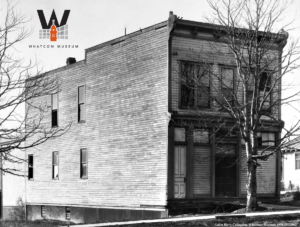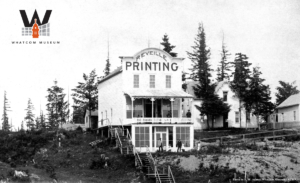Whatcom’s Newspaper War
The years from the 1890s to the 1910s were a turbulent time for America’s journalism industry. William Hearst and Joseph Pulitzer were in a fierce circulation war that had pushed the United States into the Spanish-American War. But journalism’s mighty waves weren’t a faraway thing. In fact, Bellingham was the scene for its own newspaper war.
From 1903 to 1911, two of Bellingham’s largest newspapers, The American Reveille and The Bellingham Herald, were in a seven-year circulation war that cost their owners, two wealthy publishing tycoons, tens of thousands of dollars.
Background
On June 15, 1883, Will Jenkins and Thomas Nicklin published the first edition of the Whatcom Reveille. On March 11, 1890, William Vissener, a Kentucky-born Civil War Colonel, and E. G. Earle, a local business man, printed the first edition of the Fairhaven Herald.
The two papers were in different towns at the time. The Reveille was in the Sehome area and the Fairhaven Herald was in Fairhaven, but it wouldn’t be long before the two worlds collide.
Both papers served the community without much competition. The economic boom in the area ensured that both papers were prosperous. The good times didn’t last, though, and all the papers in Whatcom felt it. By the beginning of 1891, Fairhaven’s economy began to crash and the newspapers took most of the financial blow. This depression allowed the Fairhaven Herald, which had fared better than other papers, to buyout some small papers in the area.
As the economy improved, both the Fairhaven Herald and the Daily Reveille survived the depression and continued printing daily papers. A thriving economy brought the towns of Sehome and Whatcom closer together and talk of unification started. This meant that the paper’s markets started to merge. The stage was set for a show-off between the papers. All it took was the money and drive from two wealthy men to set it off.
Whatcom’s Newspaper War
The first signs of conflict came in August 1903 when Samuel A. Perkin, publisher of The Tacoma Daily News and Ledger, saw the chance for profit in Bellingham. He bought a majority of the Fairhaven Herald’s stock. With a majority share, Perkins was able to call the shots. During the buyout, the paper’s name was change to The Bellingham Herald.
Perkins wasn’t the only man to see an opportunity for profit in Bellingham’s newspaper market. In September 1904, the founder and publisher of The Seattle Times, Joseph Blethen, formed the American Printing Company in Bellingham. On Sept. 10, he published the first edition of the Puget Sound American. In an editorial, Blethen wrote that the Puget Sound American would be a “larger and more aggressive newspaper than was ever published in any similar city in Washington State.”

The Fairhaven Herald Building, built 1890 at the southwest corner of Larrabee and 14th Streets, Fairhaven.
So ensued a long battle between the three newspapers. Every so often, each paper would change their masthead slogans with phrases that asserted themselves as the best paper in Bellingham. A March 17, 1906 slogan from the Puget Sound American read “The American is the Only Bellingham paper that dares to print the news.”
In December 1906, the Puget Sound American bought The American Reveille for $100,000.
The newly consolidated paper ran under three different names. The morning edition was called The Reveille, the evening edition was called the Evening American, and the weekly publication was called The American Reveille.
The two remaining papers, both backed by funding from their wealthy owners, fought for dominance of the newspaper market. Often, both papers were running at a deficit. However, their owners kept investing to keep them operating.
On June 14, 1908 the Reveille, in an attempt to secure its legitimacy, called on its long history in the Bellingham community by printing its Silver Anniversary edition to celebrate 25 years of operation. The special edition included phrases that called for hope of a better future in Bellingham. Twenty-thousand copies of the newspaper were printed and distributed, costing the company $2,000 (about $49,825 today).
In response, The Bellingham Herald printed a special 76-page Christmas edition that December.
On May 23, 1909, the Reveille moved into the Triangle Building on the corner of Magnolia, Commercial, and Champion streets. Then, on Jan. 1, 1910, the Herald succeeded in obtaining the franchise for the Associated Press Sunday morning news. This, along with other factors, spelled the end for the Reveille, and the end of the newspaper war.
Decline & Aftermath
On Nov. 22, 1911, Blethen sold the Reveille to a syndicate of local businessmen. In an editorial written in the last edition of the paper, he said he had hoped the paper would have turned a profit sooner. There is some speculation about why the businessmen purchased the newspaper. The common consensus is that the acquisition of the paper was part of a large plan to spur Bellingham’s economy by making it the terminus of a rail line.
The syndicate of businessmen made Frank I. Sefrit — a previous manager of papers in Portland and Salt Lake City — publisher of the paper.
Whatever the reason for the sale, many people in the community here happy that the newspaper war was over. The war had given Bellingham a bad image.
In a statement, Sefrit explained how “for years Bellingham has suffered immeasurably from the strife that has been engendered by, and between, the daily newspapers of this city. This warfare had given the impression…that the people of this city and county are hopelessly divided on everything tending to the up building of the community.”
In a Nov. 22 editorial in The Bellingham Herald, the editors wrote that the “newspaper war has become a stench in the nostrils of everybody.”
On March 13, 1927, the Herald ran a story reporting that the Reveille was being absorbed and the paper would “commence an ‘all-day’ service consisting of morning (except Mondays), evenings and Sunday edition superior in character to those which The Reveille has ever attained.”
The history of Bellingham’s early newspapers is full of competition and acquisitions. But it was the feud of two major newspapers, each backed by wealthy outside men, that divided the community, just as the feud between Hearst and Pulitzer divided the nation.
Sources & Further Reading:
Cutter, William Richard. American Biography. Pub. under the Direction of the American Historical Society, 1916.
National Register of Historic Places, Bellingham Herald Building, Bellingham, Whatcom County, Washington, National Register Number #13001032
Sampler, Rhio. “Bellingham.” Bellingham Newspapers, 12 Apr. 2008, wagenweb.org/whatcom/news.htm.
Van Mierte, E Rosomende Ellis. The Abstract + Brief Chronicles of Bellingham Bay WA. 1st ed., Threshold Documents, 2012.
“VII: The History of Newspapers.” History of Whatcom County, by Lottie Roeder. Roth, W.C. Cox Co., 1974, pp. 584–590.
About the Writer
Colton Redtfeldt is an intern at the Whatcom Museum. He is also a student at Western Washington University where he studying journalism. This piece is part of a larger research project.







Leave a Reply
Want to join the discussion?Feel free to contribute!